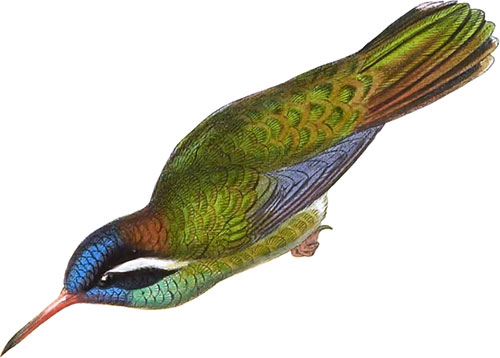Near to these are the members of the genus Heliopædica.
Generic characters.
Male.— Bill straight, and rather longer than the head; head round, or with the feathers not advancing on the bill; tail slightly rounded, the feathers broad; tarsi clothed; hind toe shorter than the middle one; head and breast luminous.
Female.—Unadorned.
This genus comprises two species, both of which are natives of Central America, Mexico, and Southern California; they are somewhat diminutive in size, and possess the white mark behind the eye which occurs in most of the members of the genera of this section of the Trochilidæ.
Heliopædica melanotis
Habitat: Guatemala and Mexico
 Plate 64
Heliopædica melanotis
Black-eared Humming-bird
Plate 64
Heliopædica melanotis
Black-eared Humming-bird
I observe that specimens from Guatemala are much smaller than those from Mexico; but as the colouring and disposition of the markings are precisely similar, I regard them as races only.
M. Sallé, in his ‘List of the Birds of Mexico,’ has assigned to one of them the name of lucidus of Shaw, believing it to be an earlier name for this bird than melanotis or Arsenni. This list has been followed by Dr. Sclater in his papers on the birds received by M. Sallé from and collected by M. Boucard in Oaxaca; but as Shaw’s description of lucidus, as well as the country in which it is said to be found (Paraguay), does not accord with that of melanotis, that name must sink into a synonym.
“In some of the open savannahs scattered among the oak-forests of the Volcan de Fuego near Calderas, this species is not uncommon; I have also frequently met with it in some of the ‘barrancos’ of the same volcano. The white mark running from the eye and the deep coral-red of the bill show conspicuously in the living bird. It is a very shy species. A single specimen was shot near Coban, and another was brought to me from the mountains of S. Cruz, near San Gerénimo.”—Salvin in Ibis, vol. ii. p. 271.
Heliopædica Xantusi
Habitat: Southern California
 Plate 65
Heliopædica Xantusi
Xantus’s Humming-Bird
Plate 65
Heliopædica Xantusi
Xantus’s Humming-Bird
If I have extolled the members of the genus Cometes as being among the most gorgeous birds in existence with regard to the colouring of their tails, in like manner I may pronounce the Topaza, which now claim our notice, to be as remarkable for their lustrous throat-marks.
One of these beautiful birds, the Topaza Pella, is an-inhabitant of Cayenne and the adjacent countries; while another, the T. Pyra, flies in the forests of the Upper Rio Negro.
Featuring all 422 illustrated species from John Gould’s A Monograph of the Trochilidæ, or Family of Humming-Birds arranged by color.